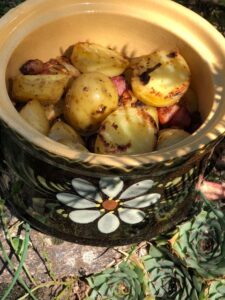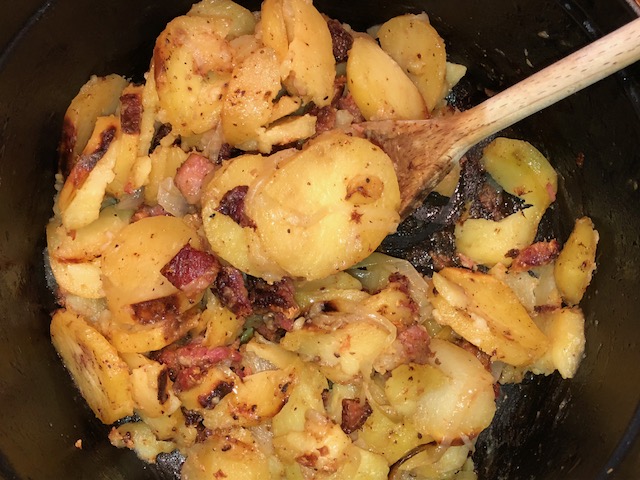When I recently stopped by what had become my friendly butcher shop in the village of Ingersheim in northeast France, a broadly smiling cashier handed me an extra bundle. It was wrapped in brown paper and weighed about half as much as my son did at birth. “What’s this?” I asked, thinking that perhaps she had given me another customer’s order by mistake.
“Une épaule de porc,” she replied, patting herself on one shoulder in case I didn’t know the word for the relevant body part. Then I realized that it was a freebie – either part of a promotion for customers who dropped more than a certain sum, or a kind gesture for l’americaine who’d been eating her way through the store’s display case for the past several weeks.
Either way, I had absolutely no idea how to make use of it. In the other bundle was sufficient cubed pork shoulder (plus other ingredients) for the traditional Alsatian stew called baeckeoffe that I was about to make. I hardly needed another pork shoulder. Though I certainly appreciated the gesture, and didn’t want to look a gift horse in the mouth, my thought balloon read, “What am I supposed to do with this?”
The look on my face must have said it all, for despite the long line behind me, she took the time to offer some parting advice. This was smoked meat, she explained, and the first step was to go home and desalinate it. Cook it, submerged in water, in a covered casserole at 130 degrees Celsius (266 Fahrenheit) for an hour. Then it was delicious with potatoes and onions, she said, leaving me to figure out the rest.
In her magnum opus, Mastering the Art of French Cooking, my heroine, Julia Child, made French cooking accessible to American kitchens. But when in France, one encounters ingredients for which Child found substitutes – or eliminated entirely. So it is in Alsace, where my husband and I have lived for the past two Septembers. Pigs, not cattle, are the dominant meat source. And Alsatian cooking, as I discovered, incorporates everything from the tail to the snout.
So what to do with the shoulder, that area in between?
A quick search of a couple of cookbooks at my fingertips revealed that this prize package could be applied to any number of uses. For recipes that called for lard – an ingredient that seems to constitute a separate food group in that region – it was an upscale stand-in.
After desalinating the pork shoulder as instructed, I spent at least another hour translating, then tweaking and implementing a recipe that I found in our landlady’s library. The book is Les Meilleures Recettes d’Alsace, by Simone Morgenthaler, Ernest Wieser and Louis Fortmann, and the recipe is called “Pommes de terre des marcaires.” In the Munster Valley, near where we were living, the word marcaire means milkmaid. It’s derived from the German word meller – a holdover from the fact that that region has changed hands violently four times in the past 100 years.
Besides pork, potatoes and onions, salt and pepper, the only other component of this recipe is butter. The magic stems from layering the ingredients in a cast-iron casserole, with the pork on the bottom, and baking them for an hour at a very high temperature. Remove the cover after that, and the pork has crisped, the onions have turned sweet and slivery, and the potatoes are perfectly cooked and coated with a sweet brown mixture of butter and juices released by all the other ingredients. Kitchen chemistry at its best.
I recognized the aroma as one I smelled wafting out windows around Turckheim, the village where we were living. Now I knew what made a house smell like Alsace. And with one important substitution I could nearly replicate it back home in Brooklyn. (See recipe below.)
 Having hardly made a dent in that pork shoulder, on another day I bought half a pound of fingerling potatoes at the market, boiled them for 20 minutes and, while they cooled, fried some cubed pork shoulder with a small sliced onion. Then I sliced the fingerlings and sautéed them with the other ingredients until the potatoes turned brown. I served these glorified hash browns in a lovely piece of hand-painted pottery that was in our rental house.
Having hardly made a dent in that pork shoulder, on another day I bought half a pound of fingerling potatoes at the market, boiled them for 20 minutes and, while they cooled, fried some cubed pork shoulder with a small sliced onion. Then I sliced the fingerlings and sautéed them with the other ingredients until the potatoes turned brown. I served these glorified hash browns in a lovely piece of hand-painted pottery that was in our rental house.
You might not think I was cooking like a local when I transformed another hunk of that pork shoulder into pasta carbonara. But the noodles I used were an Alsatian specialty: Grand’Mère brand pâtes d’Alsace lasagnettes – an egg-based mini-lasagna that is so delicate and delicious that I left the region with three bags of it in the trunk of our car.
Along with it, as you have probably guessed, was what remained of the pork shoulder. There was absolutely no way I was going to leave it behind when we headed south to our next destination, in the Périgord. Though I was destined for the land of foie gras and goose fat, I am not one to waste food.
Our next lodgings, high above the riverside village of Beynac, had a killer view over the Dordogne River, but far less in the way of kitchen equipment than our house in Alsace – not a casserole in sight.
Still, with that pork shoulder in mind, on our first day there, I visited the Wednesday market in nearby Sarlat and bought some beautiful leeks. If only I had purchased one of those hand-painted pottery gratin dishes I saw so many of in Alsace! Instead, the metal cake pan that I found in the oven would have to do. Cooking in other people’s kitchens has its challenges.
 Our induction stovetop in Beynac had three burners, and I worked two of them at a time. First I washed and cut up the white part of the leeks and sautéed them in butter. Next, peeled, sliced and parboiled a lonesome potato that had accompanied us from Alsace. When the leeks were done, I used the same frying pan to cook about half a cup of cubed pork shoulder until it was crispy. When these other ingredients were finished, I tossed them together with a lightly beaten egg and spooned them into that cake pan that I had buttered. My concoction wasn’t enough to fill the container, so I centered it, then grated about half a cup of Comté cheese (widely available in both France and the U.S.) on top. After 20 minutes in the oven, preheated to 180 degrees Celsius (in the U.S. use 350 degrees Fahrenheit), it was done. I turned it out onto a plate for a delicious lunch.
Our induction stovetop in Beynac had three burners, and I worked two of them at a time. First I washed and cut up the white part of the leeks and sautéed them in butter. Next, peeled, sliced and parboiled a lonesome potato that had accompanied us from Alsace. When the leeks were done, I used the same frying pan to cook about half a cup of cubed pork shoulder until it was crispy. When these other ingredients were finished, I tossed them together with a lightly beaten egg and spooned them into that cake pan that I had buttered. My concoction wasn’t enough to fill the container, so I centered it, then grated about half a cup of Comté cheese (widely available in both France and the U.S.) on top. After 20 minutes in the oven, preheated to 180 degrees Celsius (in the U.S. use 350 degrees Fahrenheit), it was done. I turned it out onto a plate for a delicious lunch.
By then, as you might imagine, that bone had been so chiseled away, that it wasn’t presentable for anything but soup. But with plenty of haricots blancs, or white beans, in the market, I thought a nice stick-to-your-ribs bean soup would be the very thing.
According to Périgordian tradition, the shoulder is not, not, not the right part of the pig’s anatomy to use in this dish. When I asked a vendor in the market what besides white beans went into soupe périgourdine, she was flexible about the vegetarian ingredients: “garlic, onions, carrots, leeks, whatever you have. . .” is my loose translation of what she said. But on the subject of meat, she was emphatic, grabbing one of her own love handles for emphasis. Then, motioning to my somewhat more slender frame, she warned that one does not stay svelte eating this cuisine.
Still, I put that shoulder into the soup, along with the other ingredients. At the end of it, I had a hearty dinner. And by then that bone from Alsace was finally picked clean.
Milkmaids’ Potatoes
(Adapted from Les Meilleures Recettes d’Alsace, by Simone Morgenthaler, Ernest Wieser and Louis Fortmann)
2 pounds of potatoes, peeled and cut in thin rounds
1 medium onion, peeled and cut in thin rounds
1/2 pound smoked pork shoulder, lard or pancetta, cut in 1/2-inch cubes
1/4 pound butter, cut into 1/4-inch dots
Salt and pepper to taste
1. Preheat oven to 450 degrees Fahrenheit.
2. Layer the ingredients in a 3-quart cast-iron casserole with cover, starting with the pork, then alternating onion and potatoes, and ending with butter dots on top. Season each layer with salt and pepper.
3. Bake for an hour, let cool for 10 minutes. Then toss with a spoon before serving to incorporate the pork, which has cooked at the bottom of the casserole.
Serves 6
Deborah L. Jacobs is the author most recently of the five-time award winning book, Four Seasons in a Day: Travel, Transitions and Letting Go of the Place We Call Home, about her adventures – and misadventures – living in France. Follow her on Twitter at @djworking and join her on Facebook here. You can subscribe to future blog posts by using the sign-up box on her website’s homepage.
RELATED POSTS
In Alsace, Elevating a Once-Scorned Grape to a New Status
 Pommes de terre des marcaires, or milkmaids' potatoes, is a popular dish In the Munster Valley, near where we lived in September.
Pommes de terre des marcaires, or milkmaids' potatoes, is a popular dish In the Munster Valley, near where we lived in September.
Another glorious recipe to try! YUMMMMM
Thanks so much Deborah for your kind encouragement for our upcoming wintery 3 months in Alsace. Do you have any restaurant suggestions for the region? We’ll be staying around 15 minutes outside of Thann and I’ve noted from this post as well as your book that you have a good eye (or is that tongue?) for places to enjoy an authentic local meal. Merci d’avance pour vos conseilles!
Hi Nancy,
For the most part we cook for ourselves using seasonal ingredients. But there’s a restaurant mentioned in this post, frequented by locals, that we have enjoyed again and again: Savoring Alsace: A Slow Traveler Goes Beyond the Façades.